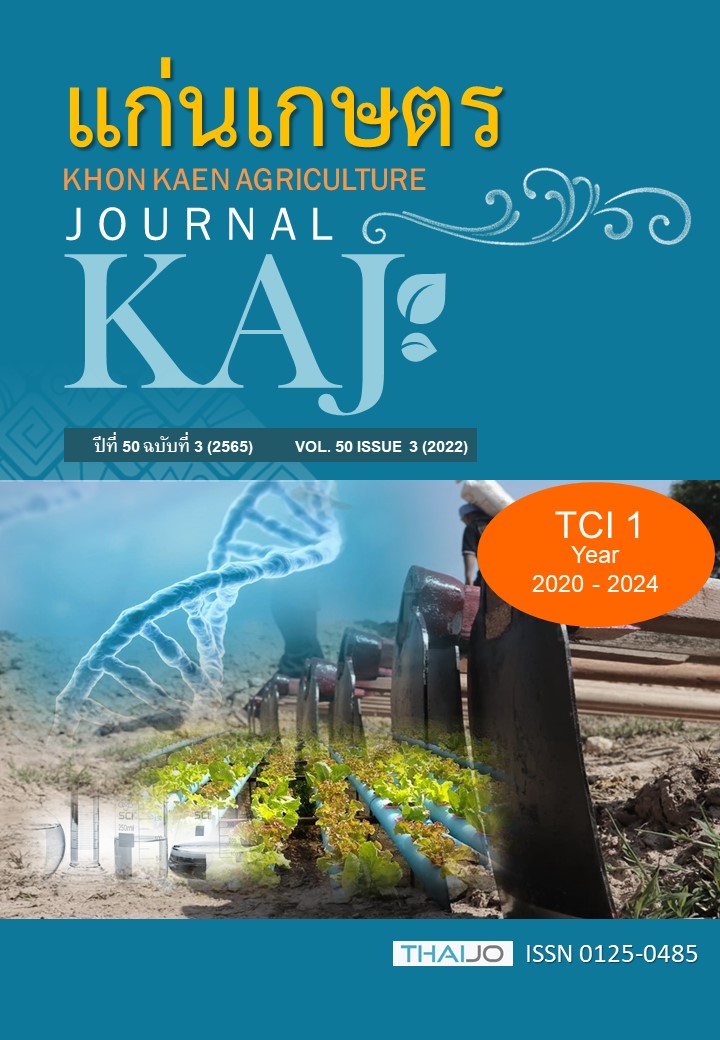อิทธิพลของความชื้นและตำแหน่งรวงข้าวที่มีผลต่อแรงดึงเมล็ดข้าวออกจากรวงของข้าวพันธุ์พิษณโลก 2 ขาวดอกมะลิ 105 และ กข6
Main Article Content
บทคัดย่อ
การทดลองนี้มีวัตถุประสงค์เพื่อศึกษาอิทธิพลของความชื้นและตำแหน่งรวงข้าวที่มีผลต่อแรงดึงเมล็ดข้าวออกจากรวงของข้าว 3 สายพันธุ์ คือ พิษณุโลก 2 ขาวดอกมะลิ 105 และ กข6 โดยแบ่งออกเป็น 3 การทดลองย่อยตามสายพันธุ์ข้าว การทดลองที่ 1 มีปัจจัยที่ศึกษา คือ ความชื้นข้าวพันธุ์พิษณุโลก 2 จำนวน 5 ระดับ การทดลองย่อยที่2 ความชื้นข้าวพันธุ์ขาวดอกมะลิ 105 จำนวน 6 ระดับ และ การทดลองย่อยที่3 ความชื้นข้าวพันธุ์กข6 จำนวน 7 ระดับ ทุกการทดลองย่อยมีปัจจัยตำแหน่งเมล็ดของรวงข้าว จำนวน 3 ระดับ ได้แก่ ส่วนล่างรวงข้าว ส่วนกลางของรวงข้าว และ ส่วนปลายรวงข้าว ผลการศึกษา พบว่า การทดลองย่อยของข้าวทั้ง 3 สายพันธุ์ มีค่าแรงดึงเมล็ดข้าวเพิ่มขึ้นเมื่อความชื้นสูงขึ้น ปริมาณความชื้น และตำแหน่งของรวงข้าวมีผลต่อแรงดึงอย่างมีนัยสำคัญทางสถิติ แต่ปฏิสัมพันธ์ระหว่างปริมาณความชื้น และตำแหน่งรวงข้าวไม่มีผลต่อแรงดึง แรงดึงเมล็ดข้าวเพิ่มขึ้นเมื่อความชื้นสูงขึ้น ข้าวพันธุ์พิษณุโลก 2 ความชื้นเพิ่มขึ้นจาก 12.72 ถึง 37.43 % w.b. มีช่วงค่าแรงดึงเมล็ดข้าวออกจากรวงเฉลี่ยอยู่ระหว่าง 1.07 ถึง 1.64 นิวตัน ข้าวพันธุ์ขาวดอกมะลิ 105 ความชื้นเพิ่มขึ้นจาก 11.77 ถึง 38.36 % w.b. มีช่วงค่าแรงดึงเมล็ดข้าวออกจากรวงเฉลี่ยอยู่ระหว่าง 0.95 ถึง 1.47 นิวตัน และ ข้าวพันธุ์ กข6 ความชื้นเพิ่มขึ้นจาก 13.54 ถึง 38.98 % w.b. มีช่วงค่าแรงดึงเมล็ดข้าวออกจากรวงเฉลี่ยอยู่ระหว่าง 1.02 ถึง 1.63 นิวตัน นอกจากนี้ยังพบว่าที่ตำแหน่งส่วนล่างรวงข้าวมีค่าแรงดึงสูงสุด และส่วนปลายรวงข้าวมีค่าแรงดึงต่ำสุดทุกการทดลองย่อย
Article Details

อนุญาตภายใต้เงื่อนไข Creative Commons Attribution-NonCommercial-NoDerivatives 4.0 International License.
เอกสารอ้างอิง
ประสาร กระดังงา, นิวัฒน์ สุวัฒนกุล และ เอนก สุขเจริญ. 2534. การศึกษาค่าความเหนียวของรวงข้าว. วิศวกรรมสาร มก. 14: 25-31.
วินิต ชินสุวรรณ. 2553. การศึกษาประเมินประสิทธิภาพเครื่องเกี่ยวนวดข้าวเพื่อลดความสูญเสียและเพิ่มศักยภาพในการส่งออก. รายงานโครงการวิจัยฉบับสมบูรณ์ เสนอต่อ สำนักงานพัฒนาวิทยาศาสตร์และเทคโนโลยีแห่งชาติ (สวทช.).
สำนักงานเศรษฐกิจการเกษตร. 2561. สถิติการส่งออกข้าวของไทย. แหล่งข้อมูล: http://www.thairiceexporters.or.th/.pdf ค้นเมื่อ 9 กุมภาพันธ์ 2562.
Alizadeh, M. R., and A. Allameh. 2011. Threshing force of paddy as affected by loading manner and grain position on the panicle. Research in Agricultural Engineering. 57(1): 8–12.
ASAE Standards, 52nd Ed. 2006. S358.2: 1:1 measurement - forages. St. Joseph, MI: ASABE.
Chinsuwan, W., S. Choun-udom, V. Udompettaikul, W. Phayom, and N. Panya. 1999. A study on harvest losses of hommali rice due to manual harvesting system and the use of combine harvester. KKU Research Journal. 4(2): 4-12.
Fangping, X., L. Xiwen, and T. Chuzhon. 2004. Rice grain separation force of ear. Study on grain and spikelet’s detaching force of paddy rice. Journal of Hunan Agricultural University (Natural Science). 30: 469–471.
IBM Crop. Released. 2019. IBM SPSS Statistics for Windows, Version 26.0. Armonk. Armonk, NY: IBM Corp.
Ichikawa, T., and T. Sujiyama. 1986. Development of a new combine equipped with screw type threshing and separating mechanism. Japan Agricultural Research Quarterly. 20: 31–37.
Kawamura, T., K. Shoji, and M. Tokuda. 2005. Measurement of force for detaching single grain of rice [Oryza sativa]. Journal of the Japanese Society of Agricultural Machinery (Japan). 64(5): 116-122.
Lee, S. W., and Y. K. Huh. 1984. Threshing and cutting forces for Korean rice. Transactions of the ASAE. 27: 1954–1957.
O'Dogherty, M. J., J. A. Huber, J. Dyson, and C. J. Marshall. 1995. A study of the physical and mechanical properties of wheat straw. Journal Agricultural Engineering Research. 62(2): 133-142.
Oduori, M.F., O.T. Mbuya, J. Sakai, and E. Inoue. 2008. Shattered rice grain loss attributable to the combine harvester reel: Model formulation and fitting to field data. Agricultural Engineering International: the CIGR Ejournal. Available: http://www.cigrjournal.org/index.php/Ejounral/article/ view/1023/1016. Accessed March 2, 2011.
Szot, B., A. Ferrero, and M. Molenda. 1998. Binding force and mechanical strength of rice grain. International Agrophysics. 12: 227–230.
Zhang, L., Z. Yang, Q. Zhang, and H. Guo. 2016. Tensile properties of maize stalk rind. BioResources. 11(3): 6151–6161.


